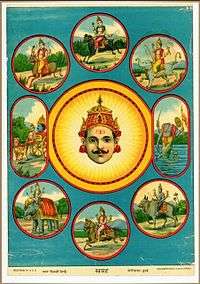Navagraha

Navagrahas, a Raja Ravi Varma painting.
Navagraha means "nine planets" in Sanskrit and are nine astronomical bodies as well as mythical deities in Hinduism and Hindu astrology.[1] These are the Sun, the Moon, Mars, Mercury, Jupiter, Venus, and Saturn, and the ascending and descending lunar nodes.
Planets, celestial bodies and lunar nodes
The term is derived from nava (nine) and graha (Sanskrit: graha "planet, seizing, laying hold of, holding").[2]
The Navagraha are:[1]
Temples
Temples that incorporate or are dedicated to one or all nine of the Navagraha are found in different parts of India, such as in Tamil Nadu.[3]
- Surya Navagrahastalam -- Suryanar Kovil
- Chandra Navagrahastalam -- Kailasanthar Temple, Thingalur
- Angaarakan Navagrahastalam -- Vaitheeswaran Koil
- Budha Navagrahastalam -- Swetharanyeswarar Temple, Thiruvenkadu
- Guru Navagrahastalam -- Apatsahayesvarar Temple, Alangudi
- Sukra Navagrahastalam -- Agniswarar Temple, Kanjanur
- Shani Navagrahastalam -- Tirunallar Saniswaran Temple
- Raahu Navagrahastalam -- Naganathaswami Temple, Thirunageswaram
- Ketu Navagrahastalam -- Nagannathaswamy Temple, Keezhaperumpallam
See also
Notes
This article is issued from
Wikipedia.
The text is licensed under Creative Commons - Attribution - Sharealike.
Additional terms may apply for the media files.

